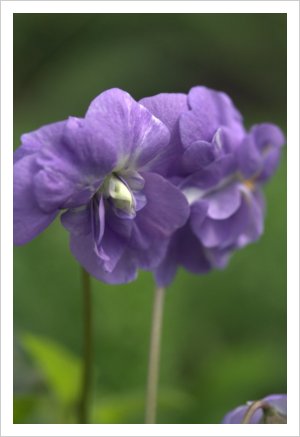Parma Violets
 Even on a cold late autumn day I’m stopped by the scent of a bed of Palma Violets planted along a path which leads from my study to the nursery. Palma violets “... possess a delightful fragrance reminiscent of ordinary sweet violet perfume mixed with that of wallflowers”.* Little wonder that in the 19th century around Grasse in the south of France there were large plantings being grown for the perfume industry. Sadly in the 1890s a synthetic violet fragrance was discovered and was soon manufactured cheaply putting an end to the production of the natural oil.
Even on a cold late autumn day I’m stopped by the scent of a bed of Palma Violets planted along a path which leads from my study to the nursery. Palma violets “... possess a delightful fragrance reminiscent of ordinary sweet violet perfume mixed with that of wallflowers”.* Little wonder that in the 19th century around Grasse in the south of France there were large plantings being grown for the perfume industry. Sadly in the 1890s a synthetic violet fragrance was discovered and was soon manufactured cheaply putting an end to the production of the natural oil.
Parma violets originated in the Levant, that is in Syria, Turkey and Lebanon. They were growing in what is now Italy by the 18th century. A favourite flower of Napoleon Bonaparte at least one variety was grown by the Empress Josephine’s gardeners at Malmaison where it was known as ‘La Violette de Parme’.
Sir Joseph Banks was a fan. His gardener, Isaac Oldaker, grew 300 plants in pots every year for him. As Parma violets aren’t as hardy as Viola odorata, the violet of English hedgerows, they were grown in glass houses in the United Kingdom.
By the end of the 19th century many millions of plants were grown for the cut flower trade in Europe, the USA and Australia. The breeding of larger and healthier clones of Viola odorata saw a decline in the popularity of Parma violets which were much more difficult to grow. After the Second World War very few were grown. Sadly now in Australia very few violets at all are grown. This decline has been fairly recent. When I first landed in Melbourne fifty years ago bunches of sweet violets could be had from every greengrocer.
 I grow two varieties of Parma violets in the garden, a double white one and a double flowered soft mauve. I’m reasonably sure that the white cultivar is called V. ‘Comte di Brazza’ as this is the only double white flowered variety on record. It was recently rediscovered in a New Zealand garden and wrongly thought to be something new and given the name ‘Le Roi’ under which it can be found in some Australian nursery catalogues.
I grow two varieties of Parma violets in the garden, a double white one and a double flowered soft mauve. I’m reasonably sure that the white cultivar is called V. ‘Comte di Brazza’ as this is the only double white flowered variety on record. It was recently rediscovered in a New Zealand garden and wrongly thought to be something new and given the name ‘Le Roi’ under which it can be found in some Australian nursery catalogues.  The original stock was bought by nurseryman Henry Cannell from the Comte di Brazza who lived near Udine in north-east Italy. Cannell, who owned Swanley Nurseries in Kent, named it ‘Swanley White’ under which name it is still grown. Whatever it’s called this violet is a really good doer and I grow it in both sun and light shade. In full flower by May, I can pick a bunch for the house every week until September. One flower, let alone a whole bunch, will fill a room with its fragrance.
The original stock was bought by nurseryman Henry Cannell from the Comte di Brazza who lived near Udine in north-east Italy. Cannell, who owned Swanley Nurseries in Kent, named it ‘Swanley White’ under which name it is still grown. Whatever it’s called this violet is a really good doer and I grow it in both sun and light shade. In full flower by May, I can pick a bunch for the house every week until September. One flower, let alone a whole bunch, will fill a room with its fragrance.
 ‘Lady Hume Campbell’, the other Parma violet I grow, is named after the person who found it growing near Milan and introduced it into Britain in 1875. For many years after its introduction it was widely grown as a cut flower, both in Britain and the US, as it has such a terrific constitution and so freely produces its exquisite, fully double, lilac-mauve white centred flowers. In my garden each plant has made a dense ground covering patch some 40cm in diameter in a season. Commercial flower growers cut the runners off each plant in the autumn to maximise the number of blooms but this isn’t necessary in the garden. Parma violets are not happy in areas with humid summers.
‘Lady Hume Campbell’, the other Parma violet I grow, is named after the person who found it growing near Milan and introduced it into Britain in 1875. For many years after its introduction it was widely grown as a cut flower, both in Britain and the US, as it has such a terrific constitution and so freely produces its exquisite, fully double, lilac-mauve white centred flowers. In my garden each plant has made a dense ground covering patch some 40cm in diameter in a season. Commercial flower growers cut the runners off each plant in the autumn to maximise the number of blooms but this isn’t necessary in the garden. Parma violets are not happy in areas with humid summers.
*Violets, The History and Cultivation of Scented Violets by Roy E. Coombs. Batsford Books 2003.